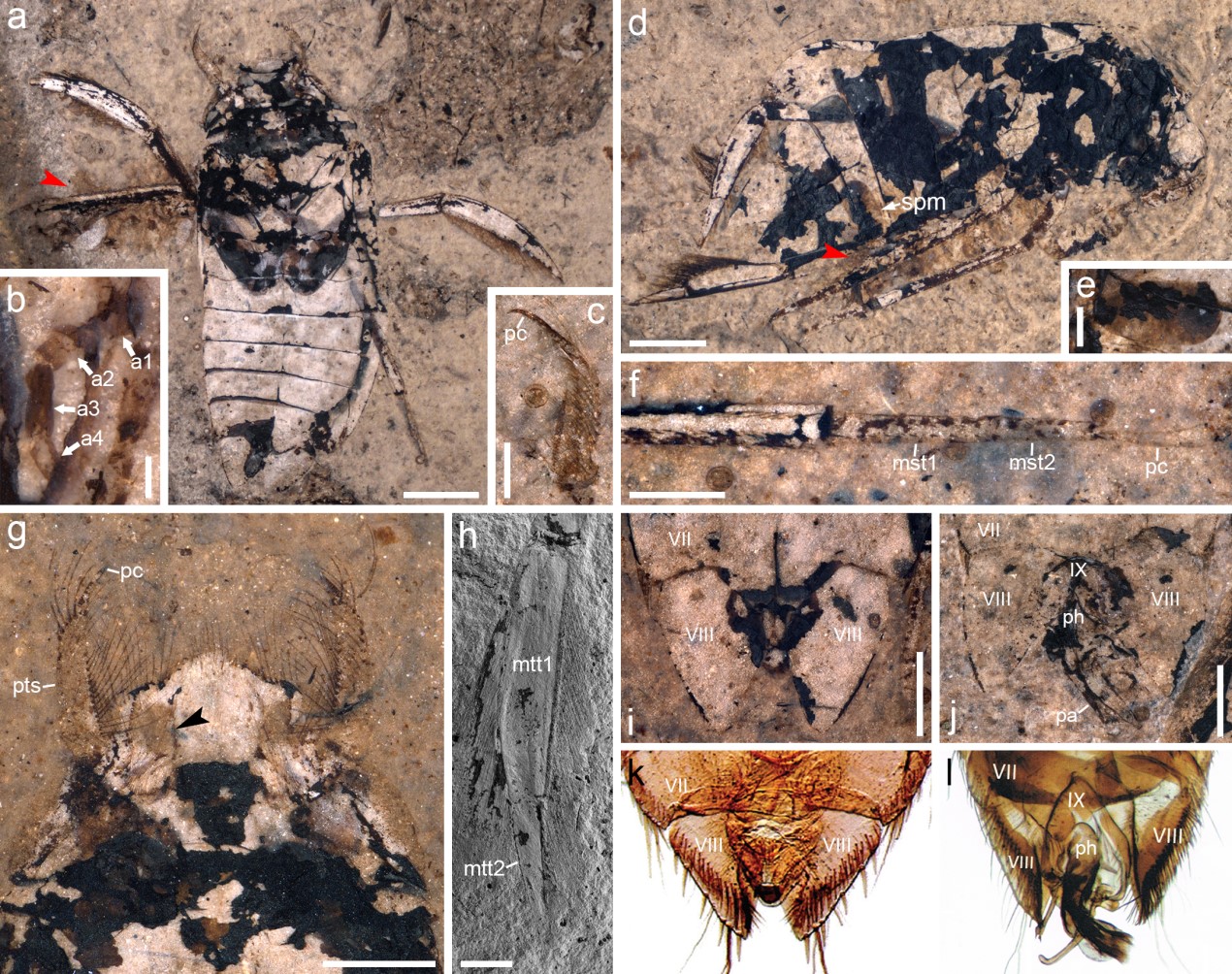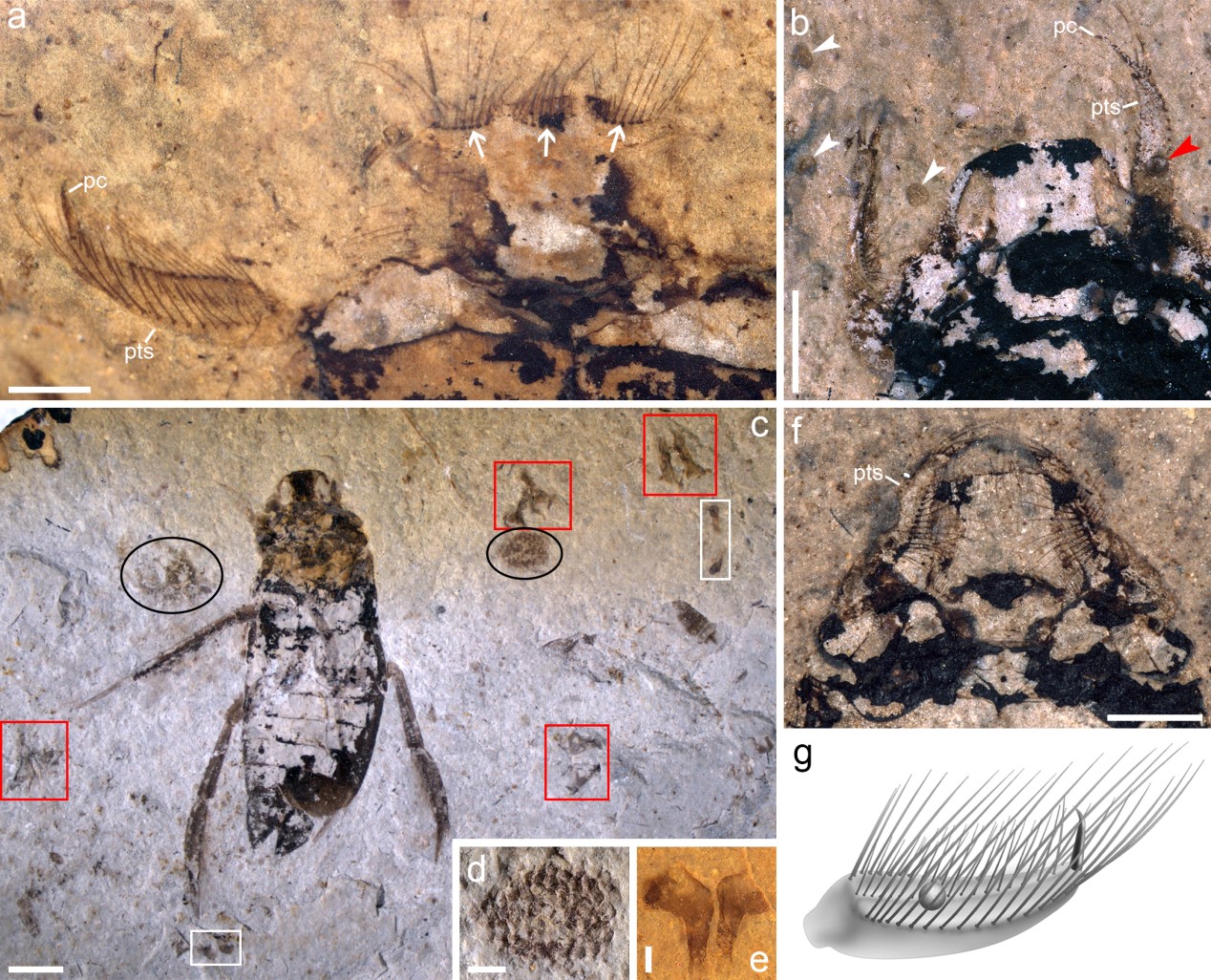Parental care refers to the protection, care and feeding of eggs or offspring by parents, is considered as a significant behavioural adaptation in life-history traits. It has evolved independently multiple times in animals, e.g. mammals, birds, dinosaurs and arthropods, especially various lineages of social insects.
Brood care is a form of uniparental care where parents carry eggs or juveniles after oviposition and provide protection, enhancing offspring fitness and survival. However, very few fossil insects directly document such an ephemeral behaviour. Among Mesozoic insects, the only two direct fossil cases of brooding ethology are from the Early Cretaceous Jehol biota and mid-Cretaceous Burmese amber.
In recent years, a research group led by Prof. HUANG Diying of Nanjing Institute of Geology and Palaeontology, Chinese Academy of Sciences (NIGPAS) systematically studied the water boatman Karataviella popovi, a representative insect from the Middle–Late Jurassic Daohugou biota of northeastern China. Of the 157 examined K. popovi fossils, 30 adult females were preserved with a cluster of eggs anchored on their left mesotibia. Various analytical technologies and methods have been used in this study, and a comprehensive analysis of functional morphology revealed the unique egg carrying behaviour of the Jurassic water boatman.
The discovery represents the earliest direct evidence of brood care among insects, indicating that relevant adaptations associated with maternal investment of insects can be traced back to at least the Middle Jurassic, pushing back by approximately 40 million years. The relevant results were published online in Proceedings of the Royal Society B on July 13th.
The true water bug superfamily Corixoidea, commonly known as the water boatman, is a common aquatic Hemipteran insect, occurs in various freshwater ecosystems worldwide. Extant water boatmen commonly deposit eggs on various subaquatic substances such as leaves or stems of aquatic vegetation, stones, and even on snail shells, carapaces of terrapins, and the exoskeletons of crayfish. The Jurassic water boatman K. popovi from the Daohugou biota bears a relatively large body, with its body length ranging from 11–15 mm.
The specialized protarsi of K. popovi, combined with the five patches of setae on the head forming a trawl-like feeding apparatus, reflecting the highly specialized predatory behavior. The anostracan and the water boatman K. popovi represent the precursors and dominators in the same layer of the Daohugou beds, and they show high consistency with their emergence, radiation, prosperity, decline and extinction. After analysis of more than 700 anostracan eggs, we hypothesize that the abundant seasonally produced anostracan eggs in the Daohugou biota probably are the food source of K. popovi.
The egg clusters of K. popovi are compact, and arranged in approximately 5–6 staggered rows, attached to and throughout the left mesotibia of adult females by short egg stalks. As inferred from the arrangement of the eggs, each row seems to have 6–7 eggs. The diameters of egg (without stalk) range from 1.14 to 1.20 mm.
This study hypothesize that due to the potential high predation risk caused by abundant salamanders in the Daohugou biota and seasonal food resources, K. popovi may have been exposed to fierce ecological pressure in the Daohugou biota. The brooding behaviour developed in K. popovi probably reflected adaptations to habitat or an evolutionary response to the ancient lake ecosystem changes. The brooding behaviour of K. popovi most likely provided effective protection for eggs, largely avoiding the risks of predation, desiccation and hypoxia, which had important effects for its evolution, development and reproductive success. However, this selfless behaviour of K. popovi incurred high ecological costs, which causes an increased risk of predation.
To our knowledge, carrying a cluster of eggs on a leg is a unique strategy among insects, but is not unusual in aquatic arthropods, in which this carrying behaviour even can be traced back to the early Cambrian Chengjiang biota.
The water boatman K. popovi could be viewed as a plesiomorphic relic. Our discovery highlights the existence of diverse brooding strategies in Mesozoic insects, which are helpful for understanding the evolution and adaptive significance of brood care in insects.
This work was supported by the National Natural Science Foundation of China, the Chinese Academy of Sciences, and the International Postdoctoral Exchange Fellowship Program. FANG Yan and LI Yan-da provided for technical support, and SUN Jie prepared the reconstructive illustration.

Figure 1. The morphological characters of Karataviella popovi.

Figure 2. Brooding in Karataviella popovi.

Figure 3. The specialized filter-capture apparatus in Karataviella popovi.

Figure 4. Ecological reconstruction of Karataviella popovi.
Contact:
LIU Yun, Propagandist
Email: yunliu@nigpas.ac.cn
Nanjing Institute of Geology and Palaeontology, Chinese Academy of Sciences
Nanjing, Jiangsu 210008, China
Download:
